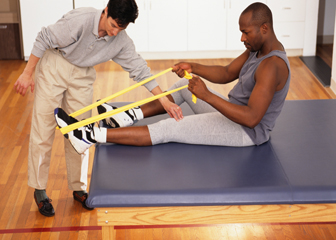
Physical therapists use a variety of techniques, such as massage and stretching, to treat patients.
Physical therapists need a Doctor of Physical Therapy (DPT) degree. All states require physical therapists to be licensed.
Education
In 2017, there were more than 200 programs for physical therapists accredited by the Commission on Accreditation in Physical Therapy Education (CAPTE). All programs offer a Doctor of Physical Therapy (DPT) degree.
DPT programs typically last 3 years. Many programs require a bachelor’s degree for admission as well as specific educational prerequisites, such as classes in anatomy, physiology, biology, chemistry, and physics. Some programs admit college freshmen into 6- or 7-year programs that allow students to graduate with both a bachelor’s degree and a DPT. Most DPT programs require applicants to apply through the Physical Therapist Centralized Application Service (PTCAS).
Physical therapist programs often include courses in biomechanics, anatomy, physiology, neuroscience, and pharmacology. Physical therapist students also complete at least 30 weeks of clinical work, during which they gain supervised experience in areas such as acute care and orthopedic care.
Physical therapists may apply to and complete a clinical residency program after graduation. Residencies typically last about 1 year and provide additional training and experience in specialty areas of care. Physical therapists who have completed a residency program may choose to specialize further by completing a fellowship in an advanced clinical area. The American Board of Physical Therapy Residency and Fellowship Education has directories of physical therapist residency and fellowship programs.
Licenses, Certifications, and Registrations
All states require physical therapists to be licensed. Licensing requirements vary by state but all include passing the National Physical Therapy Examination administered by the Federation of State Boards of Physical Therapy. Several states also require a law exam and a criminal background check. Continuing education is typically required for physical therapists to keep their license. Check with your state boards for specific licensing requirements.
After gaining work experience, some physical therapists choose to become a board-certified specialist. The American Board of Physical Therapy Specialties offers certification in nine clinical specialty areas of physical therapy, including orthopedics, sports, and geriatrics. Board specialist certification requires passing an exam and at least 2,000 hours of clinical work in the specialty area within the last ten years or completion of an American Physical Therapy Association (APTA)-accredited residency program in the specialty area.
Important Qualities
Compassion. Physical therapists are often drawn to the profession in part by a desire to help people. They work with people who are in pain and must have empathy for their patients.
Detail oriented. Like other healthcare providers, physical therapists should have strong analytic and observational skills to diagnose a patient’s problem, evaluate treatments, and provide safe, effective care.
Dexterity. Physical therapists must use their hands to provide manual therapy and therapeutic exercises. They should feel comfortable massaging and otherwise physically assisting patients.
Interpersonal skills. Because physical therapists spend a lot of time interacting with patients, they should enjoy working with people. They must clearly explain treatment programs, motivate patients, and listen to patients’ concerns in order to provide effective therapy.
Physical stamina. Physical therapists spend much of their time on their feet, moving as they demonstrate proper techniques and help patients perform exercises. They should enjoy physical activity.
Resourcefulness. Physical therapists customize treatment plans for patients. They must be flexible and adapt plans of care to meet the needs of each patient.
Time-management skills. Physical therapists typically treat several patients each day. They must provide appropriate care to patients along with completing administrative tasks, such as documenting patient progress.













